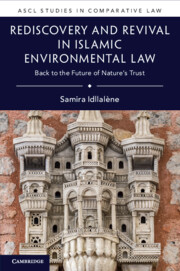Book contents
- Rediscovery and Revival in Islamic Environmental Law
- ASCL Studies in Comparative Law
- Rediscovery and Revival in Islamic Environmental Law
- Copyright page
- Dedication
- Epigraph
- Contents
- Figures
- Tables
- Preface
- Acknowledgments
- Glossary
- Acronyms
- 1 Introductory Context and Issues
- 2 What Is “Islamic Environmental Law”?
- 3 The Dormancy of Islamic Environmental Law
- 4 A Fruitful Comparison with the Common Law
- 5 Potential for Growth of Islamic Environmental Law
- Conclusion
- Select Bibliography
- Index
1 - Introductory Context and Issues
Published online by Cambridge University Press: 11 March 2021
- Rediscovery and Revival in Islamic Environmental Law
- ASCL Studies in Comparative Law
- Rediscovery and Revival in Islamic Environmental Law
- Copyright page
- Dedication
- Epigraph
- Contents
- Figures
- Tables
- Preface
- Acknowledgments
- Glossary
- Acronyms
- 1 Introductory Context and Issues
- 2 What Is “Islamic Environmental Law”?
- 3 The Dormancy of Islamic Environmental Law
- 4 A Fruitful Comparison with the Common Law
- 5 Potential for Growth of Islamic Environmental Law
- Conclusion
- Select Bibliography
- Index
Summary
Religion can play a considerable role in the protection of natural resources. The Ecological Spirituality movement is enjoying growing success crowned by the UNEP Faith for Earth initiative. In Muslim countries this movement is emerging. However, it has not yet been able to extensively exploit the law. Indeed, the particularity of the religion of Islam is that it is intertwined with the law. Consequently, this is an opportunityto strengthen environmental law. There are at least six reasons that explain the interest of the extension of Ecological Spirituality in the sphere of environmental law. These same reasons also explain the urgency of adopting a new research agenda in the field of environmental law in Muslim countries.
- Type
- Chapter
- Information
- Rediscovery and Revival in Islamic Environmental LawBack to the Future of Nature's Trust, pp. 1 - 30Publisher: Cambridge University PressPrint publication year: 2021

